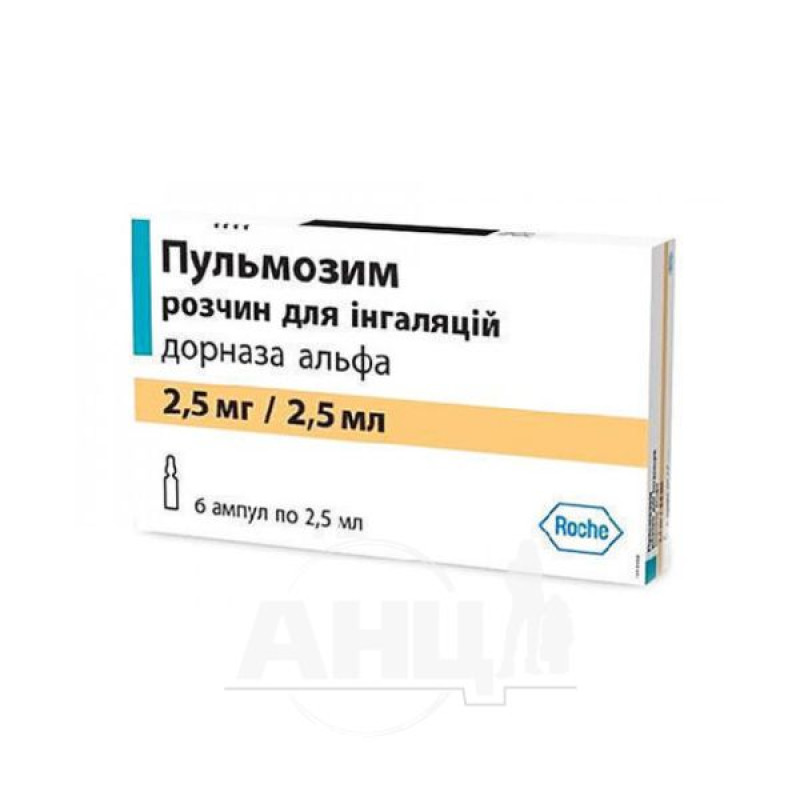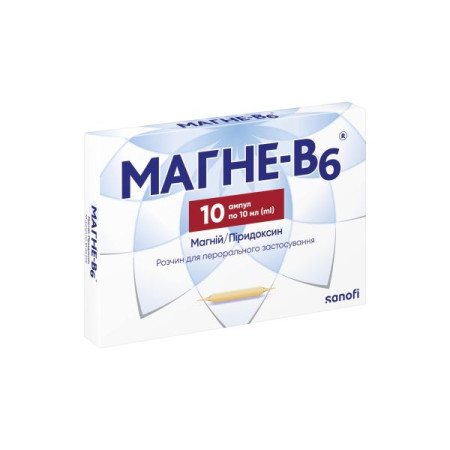Pulmozyme inhalation solution 2.5 mg/2.5 ml ampoule No. 6

Pharmacological properties
Pharmacodynamics. Recombinant human DNase (dornase alfa) is a genetically engineered version of a natural human enzyme that cleaves extracellular DNA.
The accumulation of viscous purulent secretion in the respiratory tract causes impaired respiratory function and exacerbation of the infectious process in patients with cystic fibrosis. Purulent secretion contains very high concentrations of extracellular DNA - narrow polyanion, which is released from leukocytes that are destroyed and accumulates in response to infection. In vitro, dornase alfa hydrolyzes DNA in sputum and significantly reduces the viscosity of sputum in cystic fibrosis.
Pharmacokinetics
Absorption. Systemic absorption of dornase alfa after aerosol inhalation in humans is negligible. Dornase alfa is normally found in human serum. Inhalation of dornase alfa at doses up to 40 mg for up to 6 days did not result in a significant increase in plasma dornase alfa concentrations compared with normal endogenous levels. Plasma dornase alfa concentrations did not exceed 10 ng/mL. After administration of 2500 U (2.5 mg) of dornase alfa twice daily for 24 weeks, mean plasma dornase alfa concentrations were not different from those before treatment (3.5 ± 0.1 ng/mL), indicating little systemic absorption or accumulation.
Distribution: In patients with cystic fibrosis, the mean concentration of dornase alfa in sputum 15 minutes after inhalation of 2500 units (2.5 mg) is approximately 3 μg/mL. After inhalation, the concentration of dornase alfa in serum decreases rapidly.
Metabolism: Dornase alfa is expected to be metabolized by proteases found in biological fluids.
Elimination: The level of dornase alfa in sputum decreases below half immediately after administration within 2 hours, however, the effect on the rheological properties of sputum persists for 12 hours.
Elderly (over 65 years of age): There are no data on the pharmacokinetics of dornase alfa in the elderly.
Children. Pulmozyme was administered 2.5 mg by inhalation once daily for 2 weeks to 98 children aged 3 months to 9 years (65 children aged 3 months to 5 years, 33 children aged 5-9 years). Bronchoalveolar lavage fluid was obtained within 90 minutes of the first dose. Concentrations of dornase alfa with a wide range of fluctuations (0.007-1.8 μg/mL) were detected in all children in the bronchoalveolar lavage fluid. On average, after 14 days of inhalation of Pulmozyme, serum dornase alfa concentrations (mean ± standard deviations) increased by 1.1 ± 1.6 ng/mL in the group of children aged 3 months to 5 years and by 0.8 ± 1.2 ng/mL in the group of children aged 5-9 years. The incidence of fever was higher in children aged 3 months to 5 years compared with children aged 5 to 9 years (41% and 24%, respectively). Fever is a known complication of bronchoscopy.
Indication
Symptomatic therapy in combination with standard therapy for cystic fibrosis in patients aged 5 years and older with a forced vital capacity (FVC) of at least 40% of normal to improve lung function.
Application
The solution in ampoules is intended for single inhalation use only. Pulmozyme should not be diluted or mixed with other drugs or solutions in the nebulizer container. Mixing the drug with other drugs may lead to undesirable structural and/or functional changes in Pulmozyme or another component of the mixture.
2.5 mg of dornase alfa (corresponds to the contents of 1 ampoule - 2.5 ml of undiluted solution of 2500 U) 1 time per day by inhalation, without dilution, using a jet nebulizer.
In some patients aged 21 and over, the best treatment effect can be achieved by using the daily dose of the drug 2 times a day.
In most patients, the optimal effect is achieved with continuous daily use of the drug Pulmozyme. Studies in which Dornase alfa was administered intermittently show that after discontinuation of therapy, the improvement in lung function disappears. Therefore, patients should be recommended to take the drug daily without interruption.
Patients should continue comprehensive treatment, including physiotherapy. If a respiratory tract infection worsens during treatment with Pulmozyme, its use can be continued without any risk to the patient.
The safety and efficacy of the drug have not been established for patients under 5 years of age, as well as for patients with FVC 40% of normal.
Instructions for handling the drug
The contents of one ampoule must be poured into the container of a jet nebulizer/compressor type Pari TurboBOY N, the components of which are the Pari LC Plus nebulizer and the Pari Turbo Boy N compressor.
Patients who cannot breathe through their mouth during the entire inhalation period through a nebulizer can use the Pari JuniorBOY N nebulizer, the components of which are the Pari LC Plus Junior, including the Pari LC Plus nebulizer, the Pari BABY face mask, and a compressor that is suitable for use in children.
Ultrasonic nebulizers should not be used to administer Pulmozyme, as they may inactivate Pulmozyme or cause unacceptable changes in aerosol characteristics.
The patient should follow the manufacturer's instructions for operating and caring for the nebulizer/compressor.
Contraindication
Hypersensitivity to dornase alfa and other components of the drug. Age up to 5 years.
The following are adverse reactions that have been observed during clinical trials and in the post-marketing period.
Side effects during treatment with Pulmozyme occur rarely (1/1000), in most cases they are mild, temporary and do not require dose adjustment.
From the organ of vision: conjunctivitis.
On the part of the respiratory system, chest organs and mediastinum: voice change (hoarseness), shortness of breath, pharyngitis, laryngitis, rhinitis (of non-infectious etiology), cough.
Gastrointestinal tract: dyspepsia.
Skin and subcutaneous tissue disorders: rash, urticaria.
General disorders: pleural chest pain, fever.
Research: decreased respiratory function.
Patients who experience adverse events consistent with cystic fibrosis can usually continue taking Pulmozyme. Adverse events leading to permanent discontinuation of Pulmozyme were reported in very few patients, and the frequency of discontinuation was similar for placebo (2%) and dornase alfa (3%).
After starting therapy with Pulmozyme, as with any aerosol, lung function may decrease slightly and sputum production may increase.
Antibodies to dornase alfa were detected in less than 5% of patients, but none of them were of the IgE class. Improvements in lung function were noted even after the appearance of antibodies to dornase alfa.
Special instructions
During therapy with Pulmozyme, it is necessary to continue regular medical monitoring of the patient.
After starting therapy with Pulmozyme, as with any aerosol, lung function may decrease slightly and sputum production may increase.
The efficacy and safety of dornase alfa in patients with FVC <40% of normal have not been established.
A single short-term exposure to elevated temperatures (no more than 24 hours at 30°C) does not affect the stability of the drug.
Use during pregnancy and breastfeeding. The safety of Pulmozyme for pregnant women has not been established. Pulmozyme should be prescribed during pregnancy with caution and only if the benefit to the mother outweighs the potential risk to the fetus.
When dornase alfa is used according to the recommended dosage, minimal systemic absorption of the drug is observed. Therefore, measurable concentrations of dornase alfa are not expected to be excreted in human milk. However, Pulmozyme should be administered with caution during breastfeeding.
Children. Used in children over 5 years of age.
Ability to influence the reaction speed when driving vehicles or using other mechanisms. Dornase alfa has no or negligible influence on the ability of patients to drive and use machines.
Interactions
Compatible with standard drugs for the treatment of cystic fibrosis: antibiotics, bronchodilators, digestive enzymes, vitamins, inhaled and systemic corticosteroids, and analgesics.
Pulmozyme is an aqueous solution without buffering properties and should not be mixed with other drugs or solutions in the nebulizer container. Mixing the drug with other drugs may lead to undesirable structural and/or functional changes in Pulmozyme or another component of the mixture.
Overdose
Symptoms of overdose with Pulmozyme have not been established. During clinical studies, patients with cystic fibrosis received inhalation of up to 20 mg of dornase alfa 2 times a day (a dose of 16 times the recommended daily dose) for 6 days and 10 mg 2 times a day (a dose of 8 times the recommended daily dose) in an intermittent regimen (2-week intake, 2-week break) for 168 days. 6 adult patients with cystic fibrosis received a single dose of dornase alfa IV at a dose of 125 mcg/kg body weight followed by dornase alfa SC at a dose of 125 mcg/kg 7 days later for two consecutive 5-day periods. At the same time, neutralizing antibodies to dornase alfa and any changes in antibodies to double-stranded DNA in the blood plasma were not detected. All of these doses were well tolerated.
Systemic toxicity of Pulmozyme has not been observed and is not expected due to the low absorption and short T½ of dornase alfa. Therefore, the need for systemic treatment of overdose is unlikely (see Pharmacokinetics).
Storage conditions
In a place protected from light at a temperature of 2-8 °C. Single short-term exposure to elevated temperatures (for ≤24 h to 30 °C) does not affect the stability of the drug.
There are no reviews for this product.
There are no reviews for this product, be the first to leave your review.
No questions about this product, be the first and ask your question.













